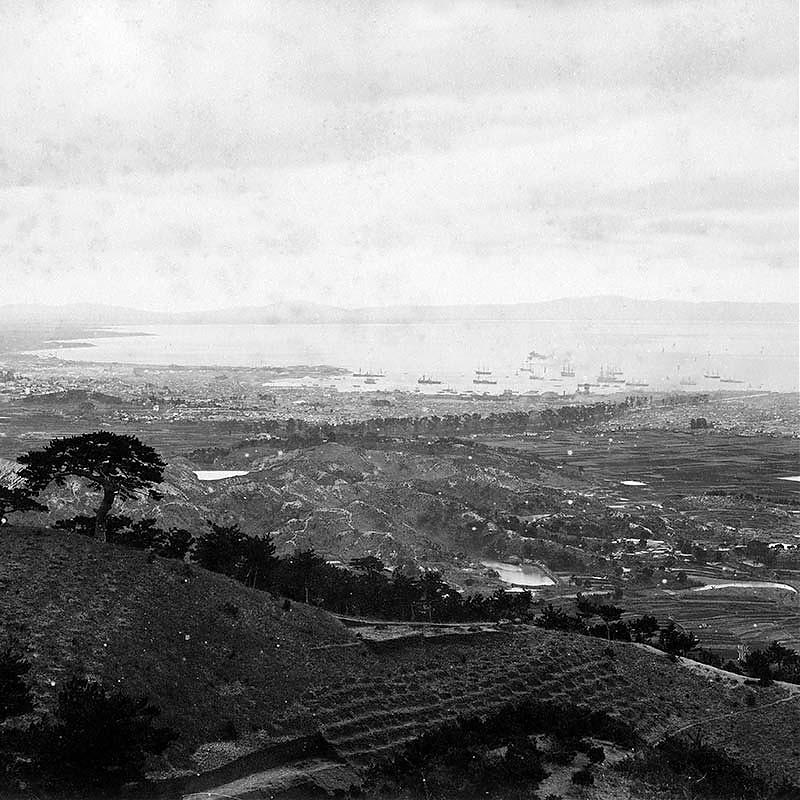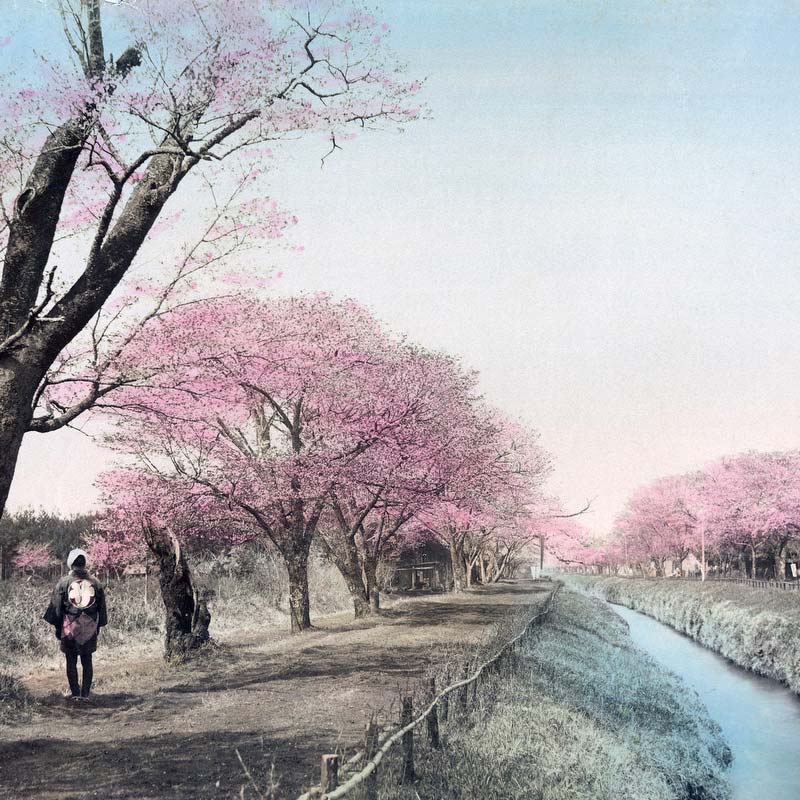A man wearing a hanten (半纏, half-coat)—probably Kozaburo Tamamura’s guide or the carrier of his equipment—stands near the entrance of the cryptomeria road (杉並木) in Hakone, Kanagawa Prefecture.
This is the old Hakone Highway (箱根旧街道) near the Ichinotorii gate (一の鳥居) at Moto-Hakone (元箱根)1. Although this was an important and well-traveled road, the road surface looks a bit painful to walk on with straw sandals. It certainly was a beautiful one, though. Through the majestic cedar trees, Lake Ashi (芦ノ湖) can be seen.
Hakone used to be an important checkpoint on the Tokaido, the main highway connecting Edo (pre-1868-Tokyo) with Kyoto. It was the tenth of the fifty-three stations (宿, juku) of the Tokaido and established in 1618 (Genna 4). Hakone-juku was first established on the Edo side of the Hakone Checkpoint (箱根関所, Hakone Osekisho). But because inhabitants of that area refused to build a honjin (本陣, inn for government officials), it was moved to the Kyoto side. Settlers were forcibly moved there from Odawara (小田原) and Mishima (三島), both juku neighboring Hakone.
The barrier (関, seki) in Hakone was manned by a large number of guards and checks were strict. Townsend Harris (1804–1878), the first United States Consul General to Japan, experienced this when he passed here in a norimono (Japanese palanquin) in 1857 (Ansei 4). On November 26 of that year he wrote in his diary2:
From the top of Hakone we had a fine view of the City and Bay of Suruga. Fusiyama (Mt. Fuji) was quite near, and altogether a different affair from the glorious view at Yugasima. A short distance on the north side of Hakone, and about one mile from the top, stands the village of that name. Here is the celebrated pass into the Yedo (Edo, current Tokyo) district, and a rigid search is made of every norimon, and each person is examined as to his passport. Here the Vice-Governor of Shimoda, after a vast deal of circumlocution, informed me that, when the great Princes of the Empire passed here, the door of the norimon was opened and an officer looked into it, without stopping the bearers; that it was a mere ceremony, but the ancient laws required it, etc., etc. I replied that, as I was not a Japanese subject, and being as I was the diplomatic representative of the United States, I was free from any such search; that they knew what was in my norimon, and could inform the officers at the pass that there was nothing forbidden in it. The Vice-Governor tried for some time to change my determination, and at last proposed that I should ride through on horseback, and then permit the search of the empty norimon. I decidedly declined this, telling him that it was the search under any form that I objected to. He then said that we must stop until he could send to Yedo for instructions, which would only take five days. I told him I should not wait five days nor five hours; that if the search was insisted on I should at once return to Shimoda. The poor Vice-Governor was in great tribulation and finally went to the guard house, and after a delay of two hours returned with word that it was all settled and that I should pass unmolested.
Established in 1619 (Genna 5), the Hakone Checkpoint was abolished in 1868 (Meiji 1). In 2007, a reconstruction of the Hakone Checkpoint was opened. It is very well-done and traditional architectural techniques were used. The site features gates, a guard house, an office, a lookout tower, a bulletin board, a shooting range, stables and a small museum.
Today Hakone is a popular resort destination, especially for people—among them many foreign residents—living in Tokyo. This popularity started early. American orientalist and author William Elliot Griffis(1843–1928) already mentioned Hakone in his 1876 (Meiji 9) book The Mikado’s Empire, which contains a lyrical description of the area3:
This range is called Hakoné, and is famous not only as classic ground in history, but also as a casket enshrining the choicest gems of nature. It is well known to the foreign residents, who resort hither in summer to enjoy the pure air of its altitudes. Its inspiring scenery embraces a lake of intensely cold pure water, and of great depth and elevation above the sea-level, groves of aromatic pines of colossal size, savage gorges, sublime mountains heights, overcrowded by cloud-excelling Fuji, foaming cataracts, and boiling springs of intermittent and rhythmic flow, surrounded by infernal vistas of melted sulphur enveloped in clouds of poisonous steam, or incrusted with myriad glistening crystals of the same mineral.
A telephone, telegraph or electric wire pole is visible in the back of the photograph. The Hakone post office first used telecommunications in July 1881 (Meiji 14)4, so this photo dates from after that period. If these are electric wires, it was taken after 1905 (Meiji 38)5.
Notes
1 Metadata database of Japanese old photographs in Bakumatsu-Meiji Period. The Hakone Road.
2 Harris, Townsend (1930). The complete journal of Townsend Harris, first American consul general and minister to Japan. Garden City, N.Y., Published for Japan Society, New York, by Doubleday, Doran & Co., 420-421.
3 Griffis, William Elliot (1876). The Mikado’s Empire. Harper, 128.
4 Metadata database of Japanese old photographs in Bakumatsu-Meiji Period. Old town by lake ashinoko.
5 Metadata database of Japanese old photographs in Bakumatsu-Meiji Period. Rows of cedars along a road.
Published
Updated
Reader Supported
Old Photos of Japan aims to be your personal museum for Japan's visual heritage and to bring the experiences of everyday life in old Japan to you.
To enhance our understanding of Japanese culture and society I track down, acquire, archive, and research images of everyday life, and give them context.
I share what I have found for free on this site, without ads or selling your data.
Your support helps me to continue doing so, and ensures that this exceptional visual heritage will not be lost and forgotten.
Thank you,
Kjeld Duits
Reference for Citations
Duits, Kjeld (). Hakone 1880s: Cryptomeria Road, OLD PHOTOS of JAPAN. Retrieved on December 14, 2025 (GMT) from https://www.oldphotosjapan.com/photos/254/cryptomeria-road




Tornadoes28
There is the famous Cryptomeria Road in Nikko as well.
#000344 ·
Kjeld Duits (Author)
Acyually, this is not Nikko in Tochigi Prefecture, but Hakone in Kanagawa Prefecture. But it does look very similar and is just as scenic. I do have some beautiful photos of the Cryptomeria Road in Nikko, too. They should go live next year.
#000345 ·
Alex W
Thank you for putting such a wonderful collection on this site. I’m fascinated by the late Meiji/Taisho period photos of Japan, especially Tokyo as I imagine what it was like in the areas I cycle around each day. May I ask if you have any old photos of Koenji? I believe it was still largely undeveloped around there until the 1923 earthquake forced residents from the centre of town. Many thanks
#000692 ·
Kjeld Duits (Author)
@Alex W
Thank you for your kind words, Alex. I have sent you a private e-mail.
#000693 ·